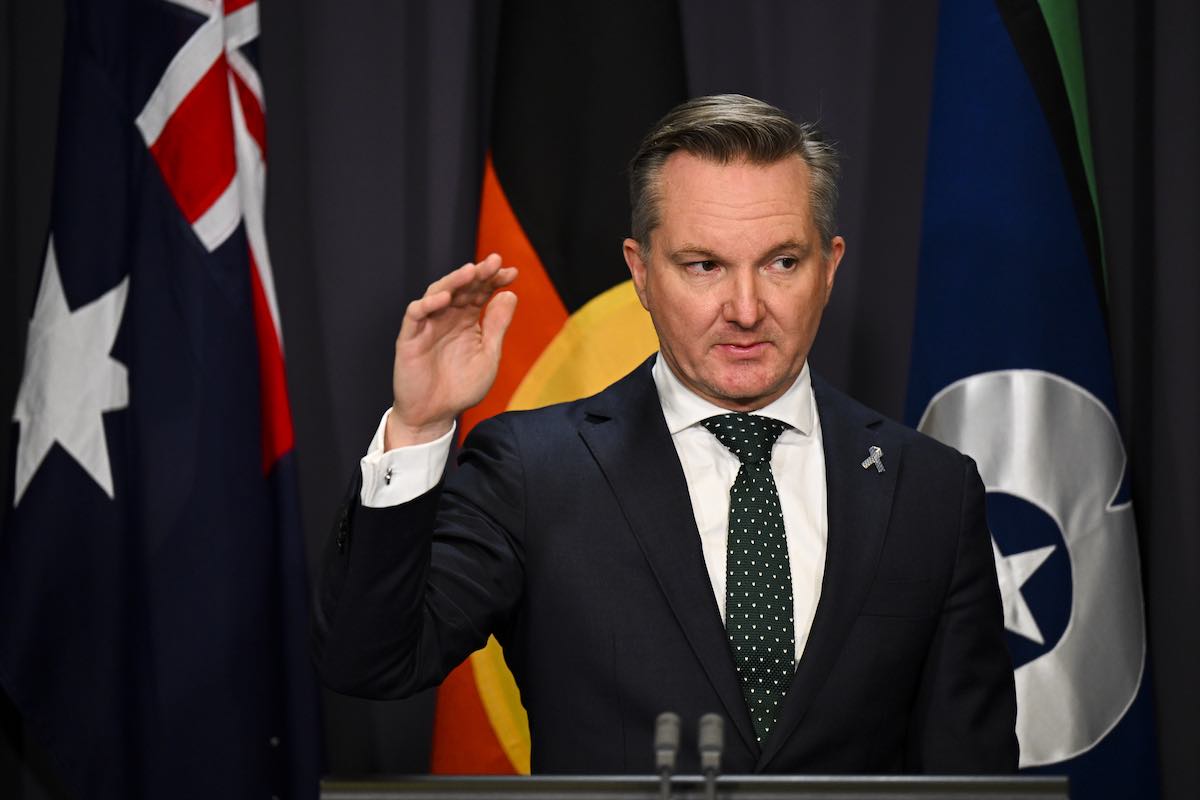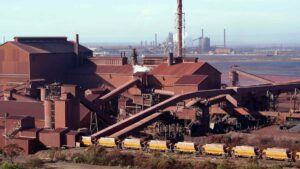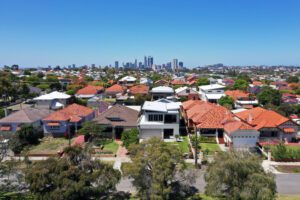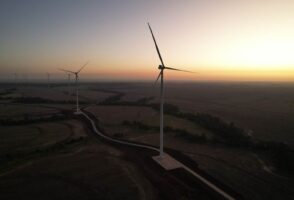Federal climate and energy minister Chris Bowen has poured scorn on the gas industry’s insistence that Australia must enjoy the “gas led recovery,” promised by the previous government, saying that the fossil fuel should not be regarded as low emissions, or a transition technology.
“The one thing about gas is I don’t regard it as a transition fuel, I don’t regard it as low emissions fuel, but I do regard it as flexible,” Bowen said in an interview for the latest episode of RenewEconomy’s popular and weekly Energy Insiders Podcast.
“So it is useful to have in the background as we’re making this massive transition to 82% renewables, because it is much more flexible than coal. You can turn it on much more quickly, so you are not wasting emissions while while it’s burning unnecessarily.
“So it will have a role to play in the system for some time. And we need to ensure that there is supply of gas to ensure it can play that peaking and firming role while we’re building the storage.”
Bowen was speaking after a week that began with the announcement of plans to impose a price cap on gas – a move that the industry warned could lead to blackouts, socialism and economic disaster – and finished with funding support for eight big batteries with advanced inverters that will help push coal and gas out of the system.
“I don’t believe in a gas-led recovery …I’ve used the term ‘bullshit’ publicly, it’s always been a fraud. Nor do I believe you can just turn away from gas immediately.”
The question about gas fields and market intervention is one of the biggest challenges for the federal Labor government as it seeks to manage the transition away from fossil fuels and accelerate the shift to renewables and electrification – in the face of economic headwinds and supply chains that is making that more difficult.
The battery storage announcement – for four gigawatt-hours of battery storage that include “grid forming” inverters that mimic the system services of coal, gas and hydro – will go a long way towards that, as will the new Capacity Investment Scheme, unveiled a week earlier, that excludes all fossil fuels.
“This is such a big transition to 82% renewables that we need all the above, we need the battery storage, we need to pumped hydro, and we need gas as a sort of safety net underpinning it,” Bowen said.
Bowen notes that the Capacity Investment Scheme, modelled on the NSW plan for auctions for capacity needs and based around a “contract for difference” that includes a cap that protects against surging prices (successfully implemented by the ACT and others), is a critical piece of legislation.
The auctions will involve a floor price to guarantee a certain income for investors, and a ceiling. “The Commonwealth will underwrite this, and in return we say you nominate a ceiling over and above which you’ll provide the profits to the Commonwealth,” Bowen says.
“So you’ll make, you know, all the money up until this point, and then you’ll hand over the profits if energy prices rise over that point to the Commonwealth.”
These were not the only initiatives in a frantic month of activity, going all the way back to the COP27 conference in Egypt.
Immediately before the podcast recording on Monday afternoon, Bowen also declared the first offshore wind zone in Australia.
Since then, he has announced a new CEFC investment in a major solar farm to unlock finance as Australia seeks to reach its new 82 per cent renewables target, and further moves to put the environment back into the national electricity market rules.
The offshore program will spark the first investments in a technology new to Australia, but already subject to tens of billions of investment in Europe, Asia and the US. Already, most of the world’s big players are lining up for a share of the action, including in the first offshore zone off Gippsland, Victoria.
“We’re the world’s largest island. So the idea of not having offshore wind in a major way is just so ridiculous. It doesn’t bear thinking about. But we do have a lot of catching up to do because we’re coming out late.”
Offshore wind, however, has two uncertainties to deal with – the costs in Australia, and the environmental impact. Interestingly, Bowen chose to reduce the size of the zone by nearly half to 15,000 square kilometres because of concerns west of Wilson’s Promontory.
“There are a lot of sensitive areas, beautiful areas west of Wilson’s Promontory, and a lot of issues to work through,” Bowen said.
“That’s not to say that we wouldn’t declare that other area at some point if those community concerns and environmental issues have been worked through. But … I won’t sign a declaration until I’m very satisfied.”
Bowen is working through several key pieces of legislation, including the Safeguards Mechanism, where we should see some progress with a position paper early in the new year, and the report into market integrity by former chief scientist Ian Chubb.
There is also the transition to EVs. The fringe benefits tax (FBT) changes have come through, now the government moves to the question of vehicle emissions standards. Bowen admitts he is using some of the 500 submissions as a doorstop to maintain his privacy at his home office during the podcast interview, but intended to read them all.
“I had a creaky door in the background, which I’d go got up and shut. But to make sure it didn’t crack during the recording, I put all my folders of national electric vehicles submissions against the door. I’ve got about 10 folders of submissions.
“I take this stuff pretty seriously, when people have gone to the trouble of making a submission, they should know that somebody reads that and it just doesn’t go off and sit on a shelf somewhere.
“So while I haven’t finished over 500 submissions yet, I’m given to believe by my office that about 100 of them deal explicitly with fuel efficiency standards and in support of them and how you might do them.
“So, again, we’ve had a fair bit on in this sort of run home to Christmas, so I’m not putting a national electric vehicle strategy out before Christmas, but it is high on our list.”
The biggest question, after the end of a year that has seen a remarkable transition in the industry outlook since the Labor election win in May, including ambitious state targets and coal plant withdrawal plans, is whether Australia can reach its renewables and emissions targets, and whether 1.5° is still achievable.
Bowen says he was shocked by the attempts to pull back from 1.5°C at the Egypt COP, which he said was led by the petrol states.
“There was a genuine, serious and coordinated attempt to water down Glasgow, which I think our listeners might be surprised to hear – and I’ll be very honest and say I was surprised, too. We did have to work hard to stop that.”
And 1.5°C? Will Australia be moved to set that as a real target if it gets to host the COP in 2026, as it hopes to do? Bowen indicates that is not likely for the short-term targets.
“We’ve lifted very bloody late to be getting to a 2030 target by starting in 2022. I mean, 84 months, for all these big transitions that we’re talking about … is not long, so you don’t have any room for slippage, and 43% emissions reduction and 84 months is actually hugely ambitious.
“The Climate statement …. was very frank and forthright. It shows we’re not currently at 43 per cent reduction target. We’re currently at 40. And we’ll get to 43 with some of the other things that government has announced but not yet implemented.
“So I think that shows that it’s not a it’s not a lazy target. It’s ambitious 43 pct, I know, you can say we shouldn’t be 50 or 75, or something, but it’s my job to actually not just set a target but to achieve it right.
So I get that I don’t get the luxury saying that should be this number, I have the task of saying it will be this number, and here’s how we’re going to get there.
“But then you get to sort of well, what’s next after 2030 is 2035, which we do have more time to influence than the eight years, obviously. So we’ll deal with that. So I don’t see it as related to the COP (bid), but I do see it as playing a massive catch up, starting very late, and doing it all at once.”










